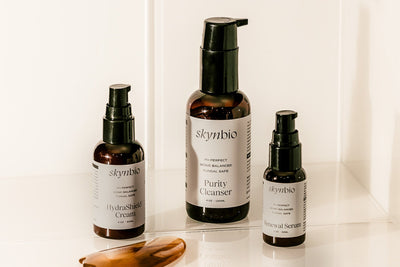When it comes to fungal acne, dermatitis, or any microbiome-related skin condition, we often focus entirely on skincare — double-cleansing, label-checking, routine-refining. But there’s one huge piece many people overlook; your makeup might be undoing all your hard work.
Yes, that tinted moisturizer. That creamy concealer. Even that “clean” foundation.
At Skynbio, we’re here to break it down. Because your skin deserves more than guesswork.
🧠 Your Skin’s Microbiome Isn’t Just A Trend — It’s Your Defense System
Think of your microbiome as your skin’s ecosystem: a balanced community of good bacteria and organisms that protect your barrier, reduce inflammation, and regulate oil. But for those of us prone to fungal overgrowths (like Malassezia), that delicate balance can be easily disrupted.
The most common trigger? Fungal-feeding ingredients hiding in everyday beauty products.
🚫 The Sneaky Culprits in Your Makeup Bag
Makeup, especially formulas marketed as “moisturizing” or “dewy,” often contains oils, esters, or ferment-based ingredients that feed Malassezia — the yeast responsible for fungal acne and flare-ups.
Common triggers include:
- Esters (like Isopropyl Palmitate, Glyceryl Stearate)
- Fatty Acids + Alcohols (Lauric Acid, Stearyl Alcohol)
- Ferments (Galactomyces, Saccharomyces)
- Certain Oils (Olive oil, Coconut oil, Squalane)
Even a swipe of foundation or a dab of cream blush can rekindle breakouts, irritation, or inflammation — especially when these products sit on your skin all day.
🔬 Why Ingredients Matter — Not Just Labels
Some makeup brands are labeled "non-comedogenic," "clean," or even “for sensitive skin,” but that doesn't mean they're fungal-safe. These claims aren't regulated, and they rarely consider the microbiome’s needs — especially if you're prone to conditions like:
- Fungal acne (Malassezia folliculitis)
- Perioral dermatitis
- Seborrheic dermatitis
- Chronic congestion and inflammation
At Skynbio, we believe it’s not just about avoiding bad ingredients — it’s about using the right ones to support your skin's barrier and balance. And your makeup should do the same.
💡 So What Can You Do?
-
Read your makeup ingredient labels like you do your skincare.
- Watch out for fungal-feeding ingredients such as isopropyl palmitate, isopropyl myristate, glyceryl stearate, PEG-100 stearate, polysorbate 20, polysorbate 60, polysorbate 80, and oils such as seed oils, castor oil, coconut oil, etc.
-
Minimize layering fungal triggers.
- If your moisturizer, foundation, AND sunscreen contain esters — that’s a triple hit.
-
Use microbiome-friendly skincare as a buffer.
- Our Clear Balance Trio is designed to calm, hydrate, and protect fungal-prone skin — so even if you slip up on makeup, your barrier is supported.
-
Look for makeup labeled fungal-safe or water-based.
- We’re curating a list of Skynbio-approved cosmetics — stay tuned.
✨ Bottom Line
You shouldn’t have to compromise your skin’s health to wear makeup. But if you’re dealing with stubborn flare-ups, it's time to look beyond your cleanser and serum — and into your makeup bag.
At Skynbio, we’re not just formulating skincare that’s microbiome-safe. We’re building a whole new standard — one that’s smart, elevated, and actually works for skin like yours.
💚 Want more guides like this?
Join our newsletter and follow us on IG @skynbioskincare for fungal-safe recs, real skin stories, and product drops. Because your skin deserves skincare — and makeup — that respects its balance.




